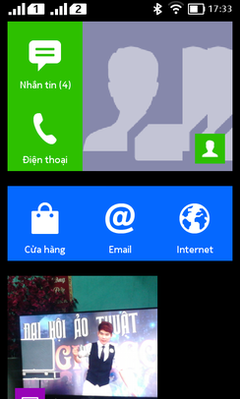 | |
 Nokia X home screen in Vietnamese | |
| Developer | Android Open Source Project (AOSP) code: Google Modifications: Microsoft Mobile (formerly Nokia) |
|---|---|
| Written in | C (core), C++, Java (UI)[1] |
| OS family | Linux |
| Source model | Proprietary software based on open source Android[2] and in all devices with proprietary components[3] |
| Initial release | 2014 |
| Latest release | Nokia X software platform 2.1 |
| Marketing target | Smartphones |
| Package manager | APK |
| Platforms | 32-bit ARM |
| Kernel type | Monolithic (modified Linux kernel) |
| Userland | Bionic libc,[4] mksh shell,[5] native core utilities with a few from NetBSD[6] |
| Default user interface | Graphical (Multi-touch) |
| License | Proprietary EULA; based on Apache License 2.0 Modified Linux kernel under GNU GPL v2[7] |
| Official website | developer |
The Nokia X platform was a Linux-based mobile operating system and software platform originally developed by Nokia, and subsequently by Microsoft Mobile. Introduced on 24 February 2014, it was forked from Android and used on all the devices of the Nokia X family. It was also the next Nokia Linux project after the ill-fated MeeGo.
On 17 July 2014, after the acquisition of Nokia's devices unit, Microsoft announced that no more Nokia X smartphones would be introduced, marking the end of the Nokia X platform within only a few months after its introduction.[8] The phones were succeeded by low-cost Lumia devices under the Microsoft Mobile brand name.[9] Microsoft did not release an Android-based device under their own brand until 2020, in the form of the foldable Surface Duo.[10]
- ^ "Android Code Analysis". Archived from the original on 14 September 2013. Retrieved 6 June 2012.
- ^ "Philosophy and Goals". Android Open Source Project. Google. Archived from the original on 17 October 2014. Retrieved 21 April 2012.
- ^ "Google's iron grip on Android: Controlling open source by any means necessary". Ars Technica. Retrieved 8 December 2013.
- ^ "libc - platform/bionic - Git at Google". android.googlesource.com.
- ^ "master - platform/external/mksh - Git at Google". android.googlesource.com.
- ^ "toolbox - platform/system/core - Git at Google". android.googlesource.com.
- ^ "Licenses". Android Open Source Project. Open Handset Alliance. Retrieved 9 September 2012.
The preferred license for the Android Open Source Project is the Apache Software License, 2.0. ... Why Apache Software License? ... For userspace (that is, non-kernel) software, we do in fact prefer ASL2.0 (and similar licenses like BSD, MIT, etc.) over other licenses such as LGPL. Android is about freedom and choice. The purpose of Android is promote openness in the mobile world, but we don't believe it's possible to predict or dictate all the uses to which people will want to put our software. So, while we encourage everyone to make devices that are open and modifiable, we don't believe it is our place to force them to do so. Using LGPL libraries would often force them to do so.
- ^ "Microsoft kills off its Nokia Android phones". The Verge. 8 April 2014.
- ^ "Microsoft Lumia 435 Dual SIM - Smartphones - Microsoft - India". www.microsoft.com. Archived from the original on 21 January 2015.
- ^ Gartenberg, Chaim (2 October 2019). "Microsoft surprises with new foldable Surface Duo phone running Android". The Verge.